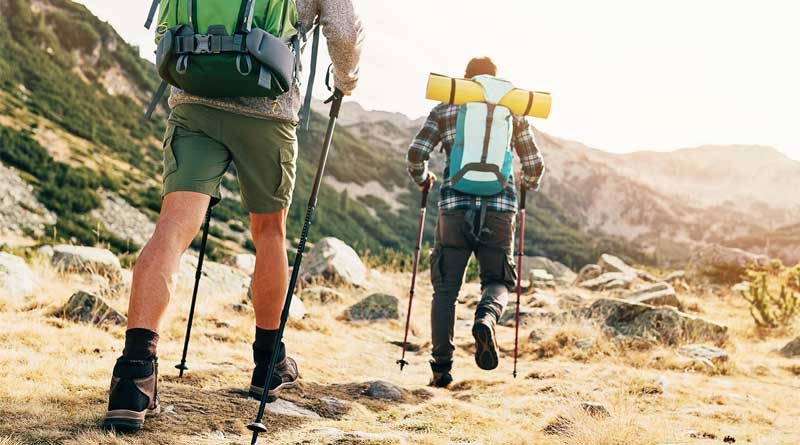Aluminum vs. Carbon Fiber Trekking Poles
A trekking pole is simply a stick with a handle and a wrist strap. You can just get yourself a stick before you hike and it serves pretty much the same purpose. However, there are some advantages of purchasing an actual trekking pole, for example, most trekking poles are adjustable meaning you can lengthen or shorten them depending on what size you are.
There are commonly two types of trekking poles i.e. aluminum and carbon fiber. The main differences between aluminum and carbon fiber poles are durability and weight. Generally, aluminum poles are more durable but heavy. On the other hand, carbon fiber poles are lightweight but they are not as durable as aluminum.
Aluminum Poles: Pros & Cons
Aluminum poles are sturdy and relatively heavy. Good aluminum poles are 7075 (or other 7-series) alloy and they will handle much more abuse than carbon. They usually weigh between 18 and 22 ounces per pair.
Pros: It is metal so it can bend and still retain its usability. However, it becomes more susceptible to breakage once it is bent. So you a second chance if they bend because you can still sue them. You can also carefully re-straighten them and continue to use them for the rest of the trip. Aluminum is a cheap material compared to carbon and you can get a decent pair of poles at an affordable price.
Cons: Aluminum trekking poles tend to be heavier due to their thick shafts, which are often less lightweight focused. They also vibrate due to the metal construction, which is not stiff like carbon. The vibration can be so annoying without shock absorbers. If you want to purchase aluminum poles, get one that is made of 7075 alloys. Anything made with a cheaper alloy such as a 6-series may break during an intense hike.
Carbon Fiber Poles: Pros & Cons
It is a matrix of fibers set in resin. The quality varies depending on the manufacturer. These poles weigh between 12 and 18 ounces per pair. A good pair of carbon fiber trekking poles can be very strong for forces aligned with the lay of the fibers (top to bottom). But they may not be very strong for forces across the fibers (side to side). The poles can be broken if the fibers are cut by abrasion or if the resin becomes fatigued through regular heavy flexing.
Pros: They are much more comfortable if you get a high-end (probably expensive) model. They feature less flex, which gives more immediate support. These trekking poles are also highly customizable and the shaft is both light and strong. They are very stiff, they don’t vibrate and feel very stiff and comfortable in hands when in use.
Cons: Where aluminum poles bend, carbon shatters. So you don’t get a second chance to use them. There is a variety of cheap carbon trekking poles available and selecting the one that is right for you can be challenging. Some manufacturers use cheap materials, which results in a weaker shaft that is too brittle and fragile. They also become more brittle in colder temperatures. It is the epoxy that makes the carbon shafts, which tends to become brittle at low temperatures, not the carbon itself.
Aluminum vs. Carbon Fiber Trekking Poles: Summary
| FEATURE | ALUMINUM | CARBON FIBER |
|---|---|---|
| Weight | Relatively heavy due to the metal shaft. | Lightweight |
| Durability | Durable if you get a pair that is made of 7075 alloy. | Less durable unless you purchase an expensive high-end model. |
| Comfort | Average comfort. | Relatively more comfortable. |
| Price | You can get a decent pair at an affordable price. | Usually expensive. |
| Reliability | Even reliable if get a budget-friendly model. | Only high-end and expensive models are reliable. |
| Best use | When you are carrying heavy load or hiking on uneven and rocky terrain or you are planning to use them to support your shelter. | When you want to go ultralight or you often carry your poles in your backpack or the trail is well-groomed and easy. |
Black Diamond Trail Ergo Cork: Best Aluminum Trekking Poles

Weight per pair: 1 lb. 2 oz.
Type: Telescoping (Lever Lock)
Grip: Cork
Basket type: Trekking, standard
These aluminum poles feature all-natural cork grips with a joint-friendly design and other grip options for different terrain and variable baskets for all-weather versatility. The pole is constructed with three telescoping aluminum sections. This forged aluminum construction gives you strong and durable support while keeping the weight low.
This telescoping construction allows the poles an adjustability range with a minimum of 27 inches and a max of 55 inches. The sturdy flick locks hold the sections of the pole together. These kinds of locks are popular due to their reliability and ease of use especially when you’re wearing gloves. The poles have cork grips. Cork provides you with a firm grip while managing moisture. Over time it will mold to your hand, giving you a custom fit.
The Trail Ergo Cork poles go a step further. Beyond being cork, the grips also have a 15-degree economically angled design. This means that you can hold the poles naturally, creating less stress on your wrists and arm joints. Below the cork grips, there are foam sections. These sections allow you to simply change your hand position in response to terrain without having to change the overall length of the pole. The adjustable high-surface wrist straps reduce stress on your joints.
The poles include carbide tech tips and low-profile 38-millimeter trekking baskets. These carbide tips can be switched out for compatible rubber tips, available from Black Diamond. This means that you can use the carbide tips when you need a bite on the icy ground but when you need a grip that won’t damage trails you can use the non-scarring rubber tips.
The baskets are also interchangeable. Wider 100-millimeter powder baskets are available for deep snow. The interchangeable tips and baskets are sold separately. These poles offer high-quality cork grips with wrist-friendly, angle interchangeable tips, and baskets make them ready to go in all four seasons.
What I like: Solid construction, comfortable, light for an aluminum telescoping pole
What I don’t: Not very packable
See the Black Diamond Trail Ergo Cork
LEKI Makalu FX: Best Carbon Trekking Poles
Weight per pair: 1 lb. 1.9 oz.
Type: Folding (Lever Lock)
Grip: Foam/rubber
Basket type: Trekking
LEKI Makalu FX carbon trekking poles are designed with ounce-counting hikers and mountaineers in mind. These carbon poles offer support and improve balance in tricky terrain while remaining surprisingly lightweight and adjustable. These poles are treated with a matte clear finish that makes them look nice in addition to protecting them from scratches. The folding poles feature three sections made of light and strong carbon fiber. High-tech carbon fiber construction combines low weight with tensile strength higher than steel offering support that won’t weigh you down.
The pull sections are connected by an inner cord. To get the poles ready for use, line up the shaft sections then pull away from the grip until you hear a click. This indicates the sections are locked into place. This Innovative design provides strong support while saving weight and increasing collapsibility. Unlike many other foldable setups, these poles also offer a short range of adjustability. The SpeedLock 2 plus lever locks allow you to easily adjust the length of the poles from about 43 inches to about 51 inches.
The poles collapse to a little less than 16 inches for storage or packing. The grips offer an ergonomic angle that preserves the natural position of your wrists to decrease fatigue. The rubberized tops of the grips have an ovoid shape and a grippy surface pattern that can comfortably be held in the palm. Adjustable straps provide peace of mind in steep terrain. The extended portion of the grips allows you to change your hand position without having to stop and readjust the pole’s length.
Carbide Flex tips Bend up to 30 degrees, which reduces the risk of poles getting bent or broken when caught on rocks or roots. The poles include LEKI’s low-profile trekking baskets, which are great for avoiding entanglements on summer trails. These can be switched with other compatible LEKI baskets to increase performance in different conditions.
What I like: Feels very premium and collapsible to 15.7 inches
What I don’t: A little expensive and heavy for a pair of carbon poles
Which one is right for you?
It depends on your particular use but the following are a few considerations besides weight and durability, which will help choose the right pair for your next adventure trip.
Trail Conditions
If you are planning to hike mostly on well-groomed trails, you should probably go for carbon fiber because carbon, even cheap one can handle easy trails. If you abuse your poles often by vaulting bogs, boulder-hopping, or leaning on them heavily during rough descents and stream crossings, go for aluminum poles because they are sturdy enough to handle these kinds of things.
Your Body Weight and Height
Taller folks, who carry heavy backpacks, should probably choose aluminum poles because they need the reliability of aluminum. On the other hand, if you are a small guy and you hike ultralight, you are less likely to break carbons.
In your hand vs. in your Pack
If you carry your trekking poles mostly in your backpack, choose carbon trekking poles. On the other hand, if you carry them in your hands mostly and use them intensively, choose aluminum because you probably want a sturdy and reliable pair of poles.
Shelter
If you are planning to use your poles to support a shelter or tarp, aluminum always adds security. You can’t afford pole breakage if you are doing this because a pole breakage may ruin your entire trip.
Budget
Carbon poles are generally more expensive than aluminum. As I mentioned earlier, there are cheap carbon poles available but they are a bit of a lottery and they can be broken at any time during your hike. If your budget is low, I would suggest always going for 7075 aluminum alloy because it is an international standard and will always be of high quality.
Conclusion
Aluminum poles are great when your budget is low and you want a decent pair. These poles, however, are a little heavy but at the end of the day, you get a sturdy pair of poles. Choose carbon when you are going ultralight and want a comfortable pair. Avoid purchasing low-quality carbon poles because they will fail on a more intense hike. When comparing shafts made of the same thickness, carbon will be lighter if they are made with the same level of quality and finish. So, it also depends on the manufacturer making the poles.





